Serengeti Explorer: Avoid the Great Migration Crowds With This Wildlife-First Lodge
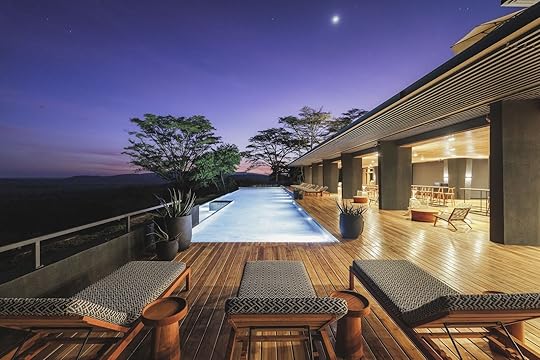
A giraffe walking next to an airplane runway isn’t something you see every day. But that’s what I saw when I stepped off my bush plane at Tanzania’s Seronera Airstrip for a one-week stay at Serengeti Explorer Lodge. Though I didn’t know it then, it was a preview of what was to come, with the next week offering near-endless wildlife sightings without the need to even board a safari vehicle.
Built into the foothills of the Nyaboro Mountains, Serengeti Explorer is a new addition to the illustrious Elewana Collection, which runs more than a dozen luxury safari resorts across Kenya and Tanzania. It sits in the western corridor of Serengeti National Park. Painted in tones that blend seamlessly with the landscape, it’s so well-integrated into its surroundings that I could barely tell it was nearby, even when we were driving almost immediately in front of it.
That first morning at Serengeti Explorer, dawn emerged in a soft pastel glow, as my jet lag had me sitting on the balcony with a steaming cup of coffee very early in the morning. On that first day, I lost count of how many giraffes, elephants, and antelopes I saw scattered across the surrounding grasslands. The green hills around the resort gave way to savanna below, where zebras and wildebeests grazed. I was amazed by how many animals I saw from my lofted, hillside vantage point – especially since I hadn’t yet set foot in a game drive vehicle.

Photo: Serengeti Explorer Lodge /Shutterstock
The 90-minute drive from the Seronera Airstrip took us through the famous Serengeti National Park. It was my first time in a national park in Africa, and I was struck by the lack of buildings, power lines, or even other humans. The park remains raw and ancient, as one of the oldest intact ecosystems on Earth.
Perhaps in homage to this utter lack of development, the hotel is built on the footprint of an older lodge. It covers the same amount of space as the former Sopa Lodge, maintaining the same number of rooms and repurposing materials when possible. This avoided clearing new land or expanding into untouched areas, I learned. While management later told me this was because the resort’s ultimate goal was to integrate with nature, not stand out, it’s also mandatory: Serengeti National Park enforces strict building regulations. No new developments are allowed within the park boundaries, and nothing can be constructed that obstructs the natural skyline.
“A pearl in the bush,” says Serengeti Explorer chief engineer Petri Van Greunen, when asked to describe the lodge. “The architects who designed this property asked one important question: how does it affect the nature around us?” He explains that every decision about the remodel was made to prioritize the park’s fragile wildlife and ecosystem. “The main goal was always the animals. We don’t want any animals to feel uncomfortable around us.”
One seemingly simple example: the lighting. “We tested all kinds of fixtures and settings to make sure none of the lights shine out into the landscape – only down or inward,” Van Greunen explained, “so they don’t disturb the environment.”
While that’s the right move from a conservation perspective, it’s also the right move from a guest perspective. During my stay, it felt like the animals didn’t know the lodge was there, either.
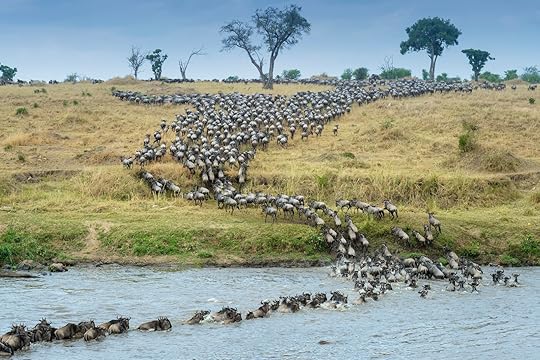
Photo: AndreAnita/Shutterstock
The vastness of the Serengeti National Park creates an ideal home for hundreds of species, from the dik-dik (the world’s smallest antelope) to massive African elephants. In the park, you’ll likely see not just a huge variety of species, but large numbers of each.
In late spring through mid-summer, hundreds of thousands of animals fill the landscape around Serengeti Explorer. That’s when the Great Migration passes through this part of the Serengeti. It’s an ongoing migration in which 1.5 million wildebeest and hundreds of thousands of zebras and gazelles travel across the Serengeti and the Maasai Mara in a continuous loop.
It’s a process essential to the landscape, as the herbivores graze and trample the grasses, making way for new growth. Their presence feeds the carnivores, and the cycle continues. Visit Serengeti Explorer during that time, and you’ll have the chance to witness dramatic river crossings and the rhythm of nature, playing out before your eyes. It’s a reminder of why the park is called “Serengeti,” meaning “endless plains” in the Maasai language.

The author on a game drive with no other vehicles in sight. Photo: Kelsey Wilking
A recent bout of heartbreaking Instagram videos showing hundreds of safari cars impacting the Great Migration has been going viral on social media. They show so many vehicles that the animals’ paths are blocked, forcing wildebeest and zebras to jump off cliffs, enter rivers at unsafe points, and otherwise change their behavior to avoid throngs of tourists.
Serengeti Explorer doesn’t participate in that kind of wildlife viewing, full stop. But the reality is, tourism plays a major role in Tanzania’s economy, funding and supporting anti-poaching efforts and national park conservation through required park fees. Our guides explained that poaching of elephants and rhinos has decreased significantly since 2020 in Tanzania, thanks to increased funding from tourism and a growing global interest in protecting the Serengeti (though poaching and snaring for bushmeat is still an ongoing concern). Tourism funds have contributed to wildlife success stories, as with the nearby Maru Rhino Project, which leads black rhino reintroduction efforts in a protected, tourist-free part of the park.
To help combat overtourism, the lodge uses six-seater safari vehicles to ensure smaller groups, and is always promoting off-season travel. The resort’s expert guides are directed to choose less-visited routes, including Serengeti Explorer’s own backroad roads, to allow for more intimate wildlife viewing in a non-crowded area. This is often the opposite tactic of quicker, more budget-focused game drives, which attempt to show guests as many animals in the shortest amount of time, with less focus on the long-term impacts. The lodge told me its goal is to create steady, year-round tourism while minimizing the noise and congestion that can negatively impact wildlife, especially during peak safari seasons.

Photo: Kelsey Wilking
While the Mara River crossings typically happen between July and October, the Great Migration is actually a year-round event. I traveled in May, just before the high season began, and mine was the only vehicles on the road for the majority of trips. We were able to watch thousands of wildebeest and their faithful zebra companions graze on the plains mid-migration. It’s amazing how much more you can actually see them when there aren’t 50 vehicles all vying for the same view.
Bird migrations from January to April also attract large numbers of travelers. But visiting in the quieter months benefits more than just the animals. It benefits you, too. With fewer people around, you get more intimate moments with nature, which is what a game drive is all about.
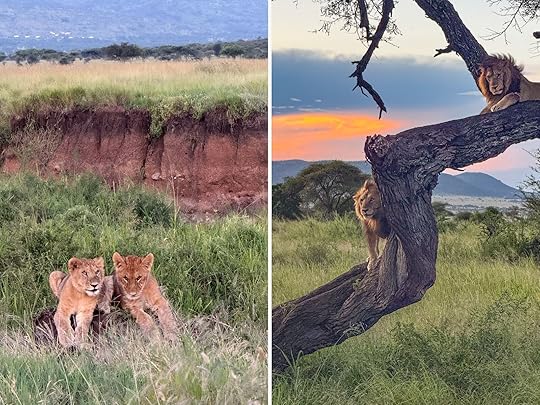
Photo: Kelsey Wilking
The Tanzania National Parks Association recently built a new road through the park, used for access to Serengeti Explorer Lodge. It’s open to the public, but because it’s so far from the main roads, it’s mostly only hotel guests who use it.
Though it’s easy to see wildlife without leaving the lodge, it’s essential to do at least a few game drives on a safari vacation. As with most safari lodges, you’ll set off early each morning and again in the late afternoon to try to catch animals at their most active.
When not watching animals, I recommend taking advantage of your safari guide’s deep knowledge of the area. Samwell Chambo, our safari guide for the week, offered a near-endless stream of wildlife facts: “Hyenas have 40 different vocalizations to communicate,” he told us while driving. And “a group of zebras is called a dazzle,” he shouted from the wheel, pointing out another sighting.
One of the most memorable sightings involved no less than 11 lion cubs playing near their den at dusk, and in total, I saw 22 species, from the tiny, rodent-sized hyrax to its biological relative, the elephant. This was my first time in Africa, and during a drive, I asked Chambo if this was normal. His response made it clear there’s something different about being in Tanzania. “The Serengeti — it’s a beautiful place,” Chambo relayed. “We have other beautiful parks, but the Serengeti, I’m sure, will fulfill any first-timer’s expectations to see many animals.”
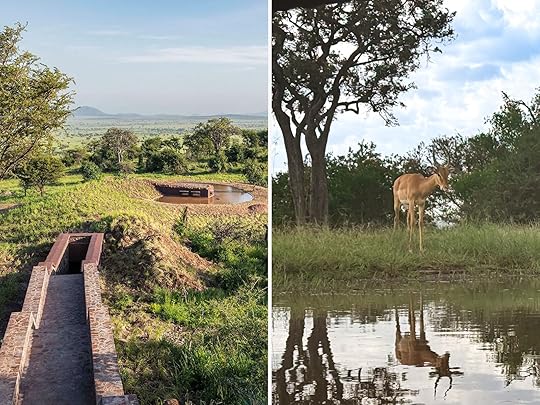
The tunnel into the Hide, and a photo taken from inside. Photo: Elewana Collection/Kelsey Wilking
At most safari lodges, skipping out on a game drive essentially means skipping out on wildlife sightings – but not so at Serengeti Explorer, as its hillside location acts as a natural refuge. The hill’s trees, rocks, and dens offer animals a quiet place to rest after spending the day feeding in the plains below. One morning, we woke to find a trail of crushed grass, indicating a herd of elephants had passed through the property overnight.
A unique feature of the resort is that it’s home to the Serengeti’s first on-site wildlife watering hole, known as “The Hide.” Guests use a tunnel to enter the partially underground room, which has windows and glass on one side. On the other side of the glass is a human-made but natural-looking watering hole, which draws everything from elephants to impalas, lions, and dozens of other mammals and birds. When drinking, they’re at roughly eye-level for the human inside, who is hidden from their view. That gives guests a front-row seat and exceptional photography opportunities. I sat there watching two antelopes knock horns. Eventually, I noticed my cheeks starting to hurt – probably because I couldn’t stop smiling.
In the evenings, I found it hard to fall asleep, even with the peaceful lull of crickets outside. In my few days at the resort, I’d been nearly face-to-face with species I’d only dreamed of seeing. My excited brain couldn’t stop thinking about what I’d seen: baby elephants splashing in a muddy puddle, zebras braying in their familial group, and lions roaring late into the evening. That excitement managed to keep me awake most nights, even with the early-morning wake-up calls for game drives.

A local artist at work at the lodge. Photo: Serengeti Explorer Lodge
While the focus is on nature, there are plenty of other things to love about the lodge. In-room spa services like facials and massages are available, and all guests have access to an infinity pool. While sitting in the water, sipping an iced mint green tea, I watched a baboon swing across the pool, moving right over my head. It paused on the edge and drank from the pool, unbothered that I was nearby.
All food at the lodge is made in-house with a menu inspired by African flavors and infused with Indian and Middle Eastern influences, reflecting Tanzania’s tourist demographic. The lodge’s decor and kitchen essentials are also sustainably sourced. Many come from Shanga, a Tanzanian craft cooperative that provides employment for people with disabilities, providing artisan training to turn recycled materials into beautiful handmade creations. My meals were served on Shanga-made tablecloths, and I sipped wine from recycled glassware.
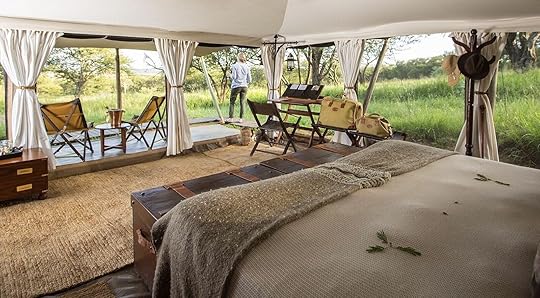
Photo: Serengeti Pioneer Camp
As if having a baboon swing overhead wasn’t enough, travelers looking to get even closer to the wild can book the resort’s partner lodge: Serengeti Pioneer Camp. It’s a fully mobile camp with a zero-footprint model, with no permanent structures. I spent one night there to get the full camp feel, and after a mesmerizing meal under the stars, I made the short walk back to my tent – only to find a harem of impala resting quietly in front of my tent. At camp, there’s a raised wildlife-viewing platform with a large telescope for spotting rhinos in the valley below, and it was there I saw the best sunrise of the entire trip. It’s a different kind of stay: more rustic, but equally magical. This add-on is separately booked, but when you book your accommodations, you can let them know you’d like to book an extra night at the campground.
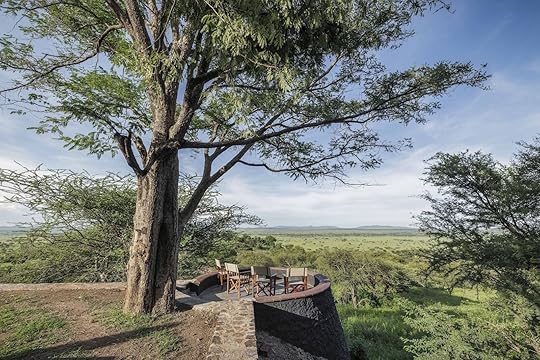
The lodge is filled with areas to relax and watch for wildlife above the savanna. Photo: Serengeti Explorer Lodge /Shutterstock
The recently opened lodge is upscale, but more approachable than better known, ultra-luxury options. Rates range from $750 to $1,930 per night for double occupancy. The full board package includes accommodation, meals, and house beverages, while the game package adds on two guided game drives per day, plus airport transfers. Serengeti Explorer can also organize your bush flights and ground transportation, working them into your final cost. You can book your own transportation to and from Kilimanjaro International Airport, but the local logistics can be tricky, so it’s usually best to let the lodge or your safari operator handle it on your behalf.
If you’re planning to visit multiple parks or stay at other camps within the Serengeti, Elewana partners with safari operators like Cheli & Peacock and SkySafari to coordinate full itineraries, including bush flights, ground transfers, or charter flights between Tanzania and Kenya, if needed. Bush flight prices vary based on the season, airline, and route, so it’s best to work directly with your lodge or safari operator when planning your trip. 
Matador Network's Blog
- Matador Network's profile
- 6 followers



